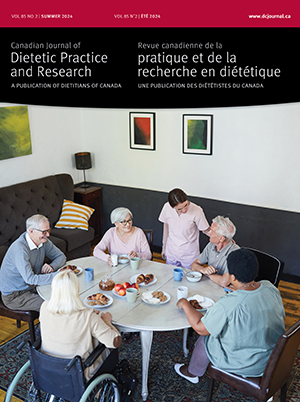Volume 79 • Number 4 • December 2018
Editor’s Message
Letter to the Editor
Research
Purpose: The current study aimed to characterize grocery shopping and dinner preparation behaviours among young people in Canada and to examine associations with eating habits.Methods: A cross-sectional online survey was conducted with 2008 participants aged 16–24 from across Canada. The survey measured self-reported grocery shopping and dinner preparation behaviours, frequency of eating breakfast and eating meals prepared away from home, frequency of vegetable and fruit intake, and socio-demographic characteristics. Chi-square tests examined differences in proportions; logistic and linear regressions examined dietary habits, including covariates for grocery shopping and dinner preparation and socio-demographics.Results: Overall, 37.3% had helped with grocery shopping in the past week, and 84.3% had participated in dinner preparation at least 1 day in the past week. Engaging in shopping at least once weekly was associated with increased vegetable and fruit consumption only, whereas more frequent engagement in dinner preparation was associated with increased vegetable and fruit consumption, more frequent breakfast consumption, and fewer meals consumed that were prepared away from home (P < 0.001 for all).Conclusions: Increased participation in grocery shopping and dinner preparation were associated with healthier dietary habits. Interventions that increase these behaviours may contribute to improving dietary behaviours among adolescents and young adults.
Purpose: The primary aim was to assess the accuracy of common prediction equations, the Harris-Benedict (HB) and the Mifflin St. Jeor (MSJ) equations, for estimating resting energy expenditure (REE) among people with spinal cord injury (SCI) against actual REE measurements. The secondary aim was to cross-validate the Buchholz et al. energy prediction equation created for people with SCI.Methods: A metabolic cart with canopy was used to measure the actual REE. The HB, MSJ, and the Buchholz et al. equations were used for the prediction of REE.Results: Thirty-nine participants (31 males and 8 females) were enrolled in this cross-sectional study. The REEs significantly differed from one another, F(1.52, 57.68) = 52.04, P < 0.001, where both the HB (M = 1703.06, SD = 265.1) and the MSJ (M = 1628.92, SD = 233.8) energy predictions were significantly higher (P < 0.001) than the measured REE (M = 1394.05, SD = 298.7). In contrast, the Buchholz et al. equation did not differ from the measured REE.Conclusions: Our data show that the HB and MSJ equations do not accurately predict the energy needs of this community. Using a SCI-specific equation would improve estimates of REE, such as the Buchholz et al. equation. More research into energy equations for this population may help health care professionals better tailor dietary requirements for weight management.
Perspectives in Practice
The impact of a hands-on foods course on undergraduate students’ food skills was examined at the University of Guelph. For a convenience sample, first- and second-year students (n = 47, 87% female) registered in the “Understanding Foods” course were recruited to participate in a survey administered on Qualtrics at the beginning of the semester and again at the end of the semester. Participants were asked questions related to demographics and food habits; additional questions on food skills, in Likert-scale format, included confidence in food preparation, food safety knowledge, and grocery shopping habits. Subscales were combined for an overall Food Skills Questions (FSQ) score and differences were determined by paired t tests. Overall, significant (P < 0.05) improvements were observed related to students’ confidence and food safety knowledge scores as well as the overall FSQ score. Students, however, rated their personal eating habits more poorly (P < 0.05) at the end of the semester. As a lack of food skills is often considered a barrier for healthy eating among students, these results signify the importance of a hands-on introductory cooking course at the undergraduate level.
Dietetic educators and practicum coordinators (PC) play critical roles in preparing students for practice. Dietitians have made significant progress in the development of educational curricula, competencies, and other resources to support knowledge and skill attainment in public health. There are identified gaps in the literature concerning practical training in sustainable food systems and public health, creating barriers in knowledge exchange and improvements in practicum programs in Canada. This paper discusses the potential opportunities and challenges associated with the number of placements for practical training in public health based on interviews with PCs in Ontario. The findings are limited to the perspectives of 7 PCs with experience in practical training and are a starting point for ongoing evaluation. Identified opportunities within traditional and “emerging settings” for practical training in public health included: the uniqueness of the experience, the potential for students to learn outside their comfort zones, and greater possibilities for dietitians in new roles and settings. Challenges included the need for significant PC engagement with nondietetic preceptors and a narrow view of dietetic practice among some dietitians. Interprofessional teams, emerging settings, and flexible learning approaches may create and support practical training opportunities in food systems and public health going forward.
The addition of Registered Dietitians (RD) to primary health care (PHC) teams has been shown to be effective in improving health and economic outcomes with reported savings of $5 to $99 New Zealand dollars for every $1 spent on nutrition interventions. Despite proven benefits, very few Canadians have access to dietitians in PHC. This paper summarizes the literature on dietetic staffing ratios in PHC in Canada and other countries with similar PHC systems. Examples are shared to demonstrate how dietitians and others can utilize published staffing ratios to review dietitian services within their settings, identify gaps, and advocate for additional positions to meet population needs. The majority of published dietetic staffing ratios describe ranges of 1 RD: 15 000–18 500 patients, 1 RD for every 4–14 family physicians, or 1 RD for every 300–500 patients with diabetes. These staffing ratios may be inadequate as surveys report ongoing issues of limited access to dietetic counseling, under-serviced populations, and a shortage of dietitians to meet current population needs in PHC. Newer projection models based on specific population needs and ongoing workforce data are required to identify professional practice issues and accurately estimate dietetic staffing requirements in PHC.
The regular documentation of anthropometric data in an electronic medical record (EMR) is one tracking method used by primary care providers to follow the growth trajectory and development of children in their health care practices. EMR reminders have been proposed as a method to increase recording of pediatric height and weight by primary care providers, leading to potentially better detection and management of children classified as overweight or obese. The aim of this pre–post study was to improve a Family Health Team’s physician documentation of pediatric height and weight through the implementation of an EMR reminder alert tool. The documentation rate for children 4–7 years old in the 6 months before intervention was 36% of children seen. After implementation of EMR reminder alerts, primary care physicians’ documentation rate rose to 45% (9% increase; P < 0.01), but it was below the 15% target increase. Better documentation of pediatric height and weight by family physicians is needed to improve monitoring of children’s growth trajectories. Additional strategies to increase documentation rates are needed.
Report
Purpose: Energy metabolism is at the core of maintaining healthy body weights. Likewise, the assessment of energy needs is essential for providing adequate dietary advice. We explored differences in energy metabolism of a primigravid woman (age: 30 years) at 1 month prepregnancy (“baseline”), during pregnancy (33 weeks), and at 3 and 9 months postpartum. Measured versus estimated energy expenditure were compared using equations commonly used in clinical practice.Methods: Energy metabolism was measured using a state-of-the-art whole body calorimetry unit (WBCU). Body composition (dual-energy X-ray absorptiometry), energy intake (3-day food records), physical activity (Baecke questionnaire), and breastmilk volume/breastfeeding energy expenditure (24-hours of infant test–retest weighing) were assessed.Results: This case report is the first to assess energy expenditure in 3 different stages of a woman’s life (prepregnancy, pregnancy, and postpartum) using WBCU. We noticed that weight and energy needs returned to prepregnancy values at 9 months postpartum, although a pattern of altered body composition emerged (higher fat/lean ratio) without changes in physical activity and energy intake. For this woman, current recommendations for energy overestimated actual needs by 350 kcal/day (9 months postpartum).Conclusion: It is likely that more accurate approaches are needed to estimate energy needs during and postpregnancy, with targeted interventions to optimize body composition.
Purpose: School food and nutrition policies have the potential to encourage healthier eating among children and youth to address rising concerns of poor diet quality. Despite their widespread implementation, there is little reported monitoring of policy adherence. This short report describes adherence to the provincial school food and nutrition policy in Nova Scotia (NS) that was implemented in 2006.Methods: An online survey was distributed to NS public schools in 2014–2015 to assess adherence to the directives and guidelines of the policy. Descriptive information was obtained for schools and indicators for policy adherence were explored.Results: A total of 242 schools completed the survey (73% response rate) and policy adherence was variable across the different components. Few schools adhered to the policy standard related to the sale of unhealthy foods and there was inconsistency in school adherence reported for other policy indicators.Conclusions: This research suggests that further action is need to ensure “minimum nutrition” food and beverages are not available in schools and that healthy eating is reinforced through prioritizing key policy actions like pricing strategies, discontinuing fundraising with unhealthy food, and ensuring food programs are available in a nonstigmatizing manner.
Purpose: To identify the impact of package size on an individual’s use of serving size information. The hypothesis was that participants would make more serving size assumption errors on a nutrition facts table (NFT) interpretation task when assessing packages that appear as a single serving but contain multiple servings, compared with products that appear as a multi-serving and contain multiple servings.Methods: Sixty participants were randomized into 1 of 3 conditions (n = 20 each); products that appeared as a single serving and contain a single serving (SSSS), products that appeared as a single serving and contain multiple servings (SSMS), and products that both appear as a multi-serving and contain multiple servings (MSMS). All 3 conditions were tested on a NFT interpretation task while participants were being presented food items that were appropriate to their given condition.Results: Participants in the SSMS (9.55 ± 7.78) condition made significantly more serving size assumption errors than the SSSS (0.00 ± 0.00; P < 0.001) and MSMS (0.40 ± 0.75; P < 0.001) conditions.Conclusions: Participants did not address serving size information when they perceived a product to be a single serving. This resulted in people misinterpreting nutritional and caloric content of foods that were single unit foods with multiple servings.










